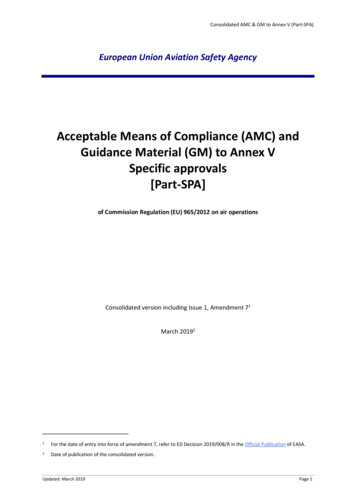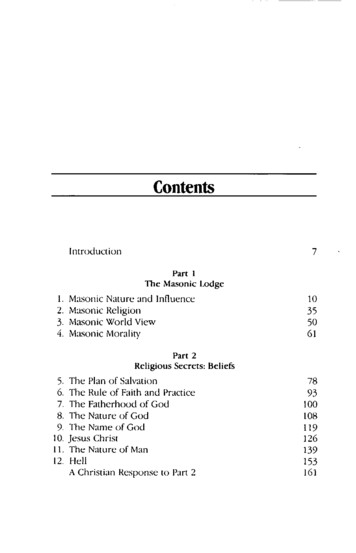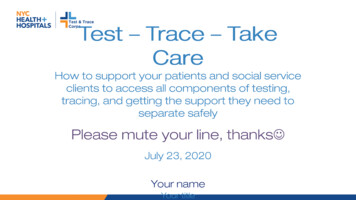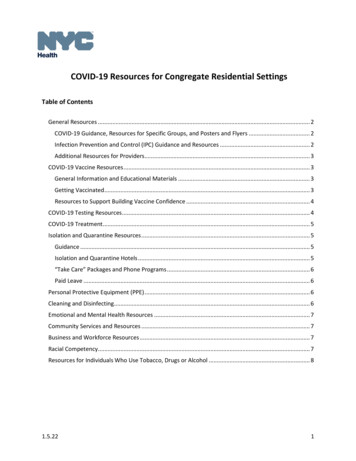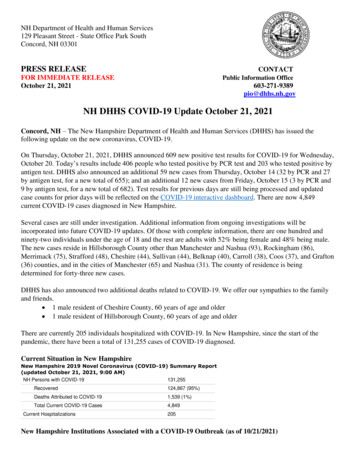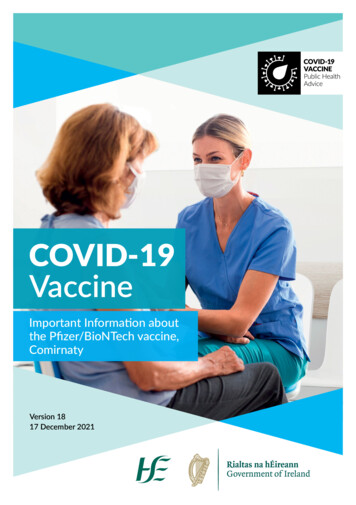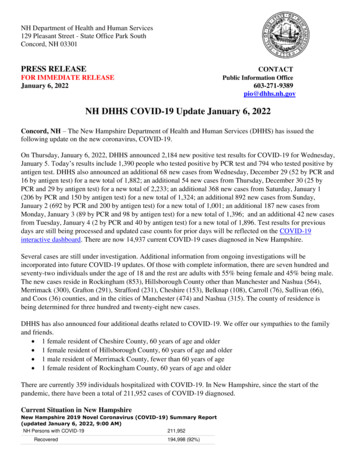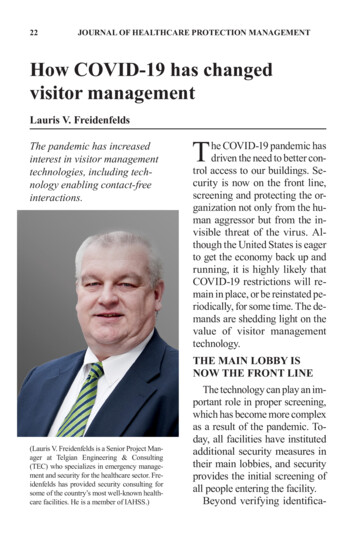
Transcription
22JOURNAL OF HEALTHCARE PROTECTION MANAGEMENTHow COVID-19 has changedvisitor managementLauris V. FreidenfeldsThe pandemic has increasedinterest in visitor managementtechnologies, including technology enabling contact-freeinteractions.The COVID-19 pandemic hasdriven the need to better control access to our buildings. Security is now on the front line,screening and protecting the organization not only from the human aggressor but from the invisible threat of the virus. Although the United States is eagerto get the economy back up andrunning, it is highly likely that COVID-19 restrictions will remain in place, or be reinstated periodically, for some time. The demands are shedding light on thevalue of visitor managementtechnology.THE MAIN LOBBY ISNOW THE FRONT LINE(Lauris V. Freidenfelds is a Senior Project Manager at Telgian Engineering & Consulting(TEC) who specializes in emergency management and security for the healthcare sector. Freidenfelds has provided security consulting forsome of the country’s most well-known healthcare facilities. He is a member of IAHSS.)The technology can play an important role in proper screening,which has become more complexas a result of the pandemic. Today, all facilities have institutedadditional security measures intheir main lobbies, and securityprovides the initial screening ofall people entering the facility.Beyond verifying identifica-
JOURNAL OF HEALTHCARE PROTECTION MANAGEMENT tion, screeners provide on-thespot health checks, such as a temperature measurement. Some organizations also require anattestation that an individual entering the building does not posea public health risk to others. Thisprocess may entail answering aseries of questions about traveland contact with others. The decision to allow entry should becontingent on predetermined expected responses, and security officers should not be given the discretion to not enforce the policy.The screening should be done according to a published policy, andrejections should be universallyapplied per this policy. The policy should be written to accommodate and adapt to changinglevels of overall threats, restrictions, and requirements.During waves of the pandemic, many hospitals have restricted almost all visitors. Exemptions were sometimes made,however, for visitation of patientswho were in very critical condition. Exempted visitors should,of course, be screened for exposure to and for symptoms of COVID-19. And those with evidence of infection or a known exposure in the last 14 days (bestpractice at the time of this writ-23ing) should not be allowed to enter the healthcare setting.Healthcare institutions nowlimit or have eliminated employee convenience entrances, suchas to the emergency department,to ensure that all people enteringthe facility are doing so via astaffed entry where manualscreening can occur. That screening can ensure that employeescomply with policies.TECHNOLOGY’S ROLEVisitor management systemsbegan to be implemented inhealth care before the C OVID-19pandemic began. Leaders saw thetechnology as a way to reduce therisk that inappropriate peoplewould enter the hospital, wherethey might make contact with avulnerable population of patients.Some form of identification, suchas a driver’s license, can be required to ensure that visitors aretruly who they purport to be.Careful consideration shouldbe given to selecting the appropriate visitor management system.The systems can be small scale,which might be appropriate forsingle offices or facilities. In larger settings, they should be leveraged for more than just issuing paper badges. In larger systems,Volume 37, Number 1, 2021
24JOURNAL OF HEALTHCARE PROTECTION MANAGEMENTthey can be robust and interfacewith a company’s active directory and perhaps a hospital’s electronic medical records and patientmanagement system. Identifyingthe need and desired function isimportant. If a complex system iswarranted, perhaps an experienced consultant is needed.Visitor management systemscan be helpful in several ways.They can, for instance, limit access based on occupancy counts,to aid in social-distancing requirements and control the number of visitors for a patient. Visitors of patients in a hospital rarely set up appointments, andsometimes the number of familymembers wanting to visit mayexceed what is acceptable for thepatient’s well-being.The interaction at the lobby,usually the first point of contact,is an opportunity to leverage thevisitor management system to establish expectations and screenfor risk. Visitor management systems can provide a point wherethe visitor can be required to provide the answers to screeningquestions so that these can bedocumented.Visitors may be instructed towear a face mask and complywith other required safety mea-sures and may be given a document with information on theprecautions they need to take. Avisitor’s understanding andagreement to comply can be documented in the system. And, asthe restrictions evolve or aremodified, the system can beadapted. Risk managers and legal teams of the organizationshould weigh in on these restrictions to ensure that liability issuesare appropriately addressed.Similarly, the visitor management systems can be utilized inoffice buildings, including thoserelated to the business side ofmedical care as well as medicaloffices. In these venues, the visits are usually scheduled prior toarrival, and the process can beinitiated much earlier than hasbeen true in the past, allowing fora more efficient process at thelobby. In many medical officebuildings, clinic visits have beenrestricted to the patient only. Thisinformation should be communicated early to avoid any conflictor angry interactions and to ensure that the person who accompanies the patient can make appropriate accommodations forthe span when the patient is being treated. Visitor managementsystems can initiate the commu-
JOURNAL OF HEALTHCARE PROTECTION MANAGEMENT nication process, informing visitors of what to expect when theyarrive at the building and also detailing procedures, restrictions,and rules for entering a facility.All of this can occur well beforethe visitor enters the facility.THE RISE OF CONTACTFREE OPTIONSThere is a trend toward increasing use of contactless methods ofinteraction. It is estimated that atleast two-thirds of Americansnow have a smartphone. The visitor management system can interface with smartphones andsend the visitor a QR code priorto arrival. The scanning of the QRcode can identify the individualand allow efficient processing. Informing patients and visitors ofwhat to expect via e-mail, textmessages, or phone calls is alsopart of this contactless trend.CONTACT TRACINGContact tracing has become animportant element in combatingthe spread of C OVID-19. Employees and visitors who test positive should have the means toself-report their status to employers and places they have visited,and public health officials shouldhave the ability to track and au-25dit the actions of those individuals. Quarantine precautions maybe required not only for the people who test positive but also forpeople who have come in contactwith them. Technology for contact tracing is evolving rapidly.The smartphone plays an important role here, as well. Smartphone apps are being developedto put this concept into action.However, these apps require thatlocation services be active on thesmartphone, and many people resist allowing location services tooperate. So, using smartphonesfor contact tracing is not foolproof. Visitor management systems can play a role in filling thatgap. An audit of the time and dayof a COVID-19-positive visit canaid in contact tracing and in warning other people who were in thearea of the possible exposure.Current contact tracing methods come into play after exposures have been identified. Workis under way to establish proactive warning methodologies.Based on GPS, Wi-Fi and otherlocation systems, these approaches may be able to send warningsto smartphones to indicate whenpotential entry into a hotspot areahas been detected.Volume 37, Number 1, 2021
26JOURNAL OF HEALTHCARE PROTECTION MANAGEMENTCRITICALCOMPLEMENTSTo be most effective, any technological solutions to visitormanagement should be pairedwith commonsense actions.Communications that outlinebest practices for preventing COVID-19 should be prominently displayed to visitors to enhance compliance. And handsanitizer should be provided atthe entry lobby desk. This actionwill not only help to prevent thespread of infection, it will alsosignal that the organization is serious about infection control andis willing to assist people entering their facility.PREPARING FORTHE NEXT THREAT COVID-19 is a profound re-minder to all of us that epidemics and pandemics are possible.Regardless of the nature of thedisease—the common annual influenza, H1N1, the coronavirus,SARS, MERS, ebola, or any other threat—everyone needs to bemore cognizant of infection prevention. Although C OVID-19 isthe latest concern, security andemergency preparedness professionals should look to implementing an all hazards approachto visitor management. Flexibility is the key.When the pandemic finallywanes, restrictions will likely beremoved, but facilities will needto adapt and prepare for the nextthreat. Having a plan and adaptable access and visitor management systems in place shouldhelp to protect organizations.
management system. Identifying the need and desired function is important. If a complex system is warranted, perhaps an experi-enced consultant is needed. Visitor management systems can be helpful in several ways. They can, for instance, limit ac-cess based on occupancy counts, to aid in social-distancing re-quirements and control the num-
